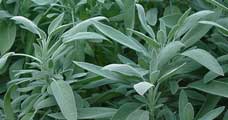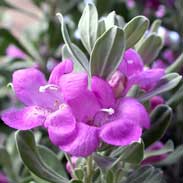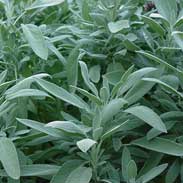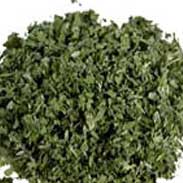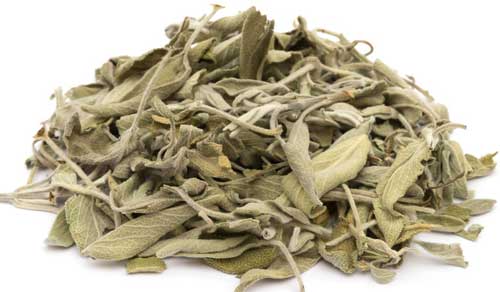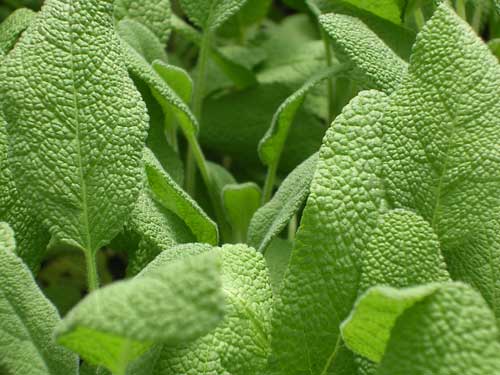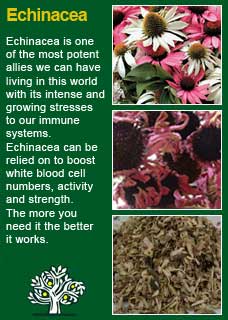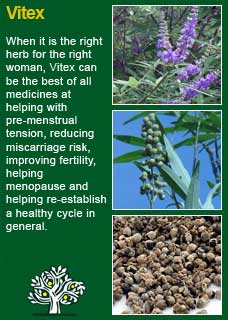
|
|
||||
| Our Pages ABOUT CONSTITUTIONAL MEDICINE
|
In herbal medicine, as in the culinary arts, we use the leathery greyish leaves of that wonderful hairy, shrubby herb called Sage. Popular in gardens all over the world, it’s a tough little grower, it smells good and it produces beautiful whorls of blue to purple flowers.
Despite being relegated in most modern people's minds to a herb used for stuffing chickens the medicinal virtues of Sage used to be regarded to such a degree that its Latin name Salvia comes from the word salvere 'to save!' Arab physicians revered Sage and believed its regular use would increase life-span. Similarly, in France Sage was called toute bonne; 'all's well' English herbalist John Gerard called Sage 'singularly good for the head and brain, it quickens the senses, restores health to those who have palsy and takes away shaky trembling of the members' An old adage goes 'Sage helps the nerves and, by its powerful might, Palsy is cured, and fever put to flight'. King's Dispensatory writes 'Sage is tonic, astringent, expectorant, and diaphoretic and it has properties common to aromatics. An infusion is beneficial in flatulence connected with debility, and will, when the skin is soft and relaxed, the extremities cold, and the circulation enfeebled, prove efficient in restraining exhausting sweats. The infusion may be taken cold throughout the day; it may likewise be used warm, as an anthelmintic, and for the purpose of causing diaphoresis in some febrile diseases. The infusion is much used as a gargle for inflammation and ulceration of the throat' TJ Lyle writes 'Sage leaves are a pleasant, mild, diffusive, stimulating tonic, slightly astringent. In hot infusion it is gently diaphoretic and quite soothing to the nerves. It cleanses and tones the mucous membrane and may be profitably used in throat troubles from colds and in respiratory, stomach or bowel troubles from the same cause. Cold preparations are diuretic and excellent in night sweats' The British Herbal Pharmacopoeia (BHP) describes Sage's actions as carminative, spasmolytic, antiseptic, astringent, antihidrotic (to alleviate excess sweating) and says it is indicated for dyspepsia, pharyngitis, uvulitis, stomatitis, gingivitis, glossitis, internally or as a gargle or mouthwash. Hyperhidrosis and galactorrhoea and specifically indicated for inflammation of the mouth, tongue or throat, as a gargle or mouthwash. The BHP suggests a dose of 1-4 gms or by infusion or a dose of 1-4mls of the ethanolic extract. Sage has been used for many illnesses since ancient times. The most enduring uses of Sage that persist to this day can be divided into several categories.
~ In a number of open studies, Sage has reduced sweat production in patients with hyperhidrosis (excessive sweating). The daily dose ranged from the equivalent of 2.6 to 4.5 grams of leaf (European Scientific Cooperative on Phytotherapy monographs, UK, March, 1996) ~ A product containing Sage and Alfalfa extracts produced improvement in the menopausal symptoms of hot flushing and night sweats in an open trial conducted for 3 months (De Leo V et al: Minerva Ginecol 50(5):207-211,1998) ~ Laboratory studies with Sage have shown that is has anti-microbial properties and has constituents that protect against damage to the walls of our cells. Sage extract and Sage oil can reduce a substance called acetylcholinesterase in the human brain and it may be that this is how it has its effects on such diverse symptoms as excess sweating and poor memory (Oerry N et alL Int J Geriatr Psychiatry 11(12):1063-1069,1996) ~ There are well over 300 published studies and articles on Sage, a PDF showing their titles, authors and when and where they were published can be found here
For most people, young or old, Sage is a very safe medicine that can be used in high doses if required. However, Sage may be best avoided as a high dose medicine during pregnancy and it has traditionally been used to help dry up breast-milk so it should not be taken during breastfeeding unless coming to an end.
For some years now, against this proven and safe way of herbalism, there has been a rising tide of excessive caution and scare-mongering in many parts of the world. The same authorities that, not so long ago, decried herbal medicines as ineffectual, have now taken up a different adversarial position; that they are dangerous substances that should only be prescribed by Doctors, who of course have zero training in them. Unfortunately, the same unnecessary fear and worry has crept into many natural health websites and popular publications on herbs. Herbs that we have safely used for thousands of years, that have no reports of adverse reactions in the medical literature despite widespread use by millions of people, are suddenly described as contraindicated because of something that should have been seen as completely unimportant, or at the utmost a merely theoretical concern, such as a laboratory study on one of the herb's constituents to use an all too common example. I wonder sometimes if the writers of such articles feel that the herb will be more deserving of respect if it is thought to be a little bit dangerous, in other words more like a drug than something that has simply come out of the earth and been used by ordinary people for generations beyond count. There is just so much misinformation about herbal medicine on the internet now. Ludicrous claims and cautions abound in equal measure; it seems like one group are trying to make money out of the public whilst the other are busily trying to scare them off. I have to believe that the kind of reader who takes the time to read pages on herbs that are as extensive as this one is much less likely to be swayed by marketers or misinformers. I hope that you will keep your wits about you if you get conflicting opinions from people who have never really got to know these herbs, who have never worked with them, or learned how to use them safely and effectively. I want to remind you that the reason that herbs can never be patented and owned by any individual or corporation is because they are, and always will be, the People's medicine. They belong to all of us and it is my great hope in sharing this work that you will learn how to use them wisely for yourself, and the people you care for. Be safe, but do not be afraid.
Sage can work very quickly however, like many of our medicinal herbs, dosage can be the crucial difference between success or failure and for most people high doses of Sage may be initially required. My advice is to be prepared to start strong with Sage, make sure it is working well, then be ready to cut the dose back as soon as you feel your system needing to back off. If you who are reading this are studying herbal medicine or if you just want to understand this ancient plant ally at a much deeper level for your own reasons then I warmly encourage you to make some Sage tea (just a half a tsp in a cup of freshly boiled water for 5 minutes will be ample for this experiment!) or take 10 or 20 drops of its tincture and then, with a quiet and attentive mind, observe for yourself how it makes you feel. This old way of experiential learning is a tremendous way to appreciate the power of these plants beyond where academic study can take you. I have done this experiment enough myself and with others to know not to predict to you how it will make you feel but just try and see with an open mind and I think you will be pleasantly surprised! Further to this, if you would like to learn more about the ancient art of pulse testing, a simple but powerful way to ask the intuitive intelligence of the body for its responses to a herb by feeling the pulse whilst giving a tiny dose by mouth, read here Like all herbs, much of the art of getting success with it lies in the dose. Modest doses, just a ml or so at a time, can convey its nervine benefits, or gain its local effects in the mouth or throat, but much larger amounts can be required to see a significant change to excess sweating. See the tea recipe below to see the kinds of strength that can be required in using it as a dried herb to get a result in this difficult condition. By far the largest part of my own use of Sage in practice has been in tincture form where we can easily adjust the dose up or down as needed. As a tincture, I would readily use amounts in the range of 4-6 mls, twice a day to run a trial with the herb to see if it could help, reducing the dose after getting a good result to see if the benefit was sustained at a smaller dose. Sage combines perfectly with Rosemary as a brain tonic, with Echinacea for mouth and throat problems and with St John's wort to improve mood and lessen anxiety. When not needing to use it in such high doses for excess sweating, I have found that smaller doses of Sage combined with Vitex has worked brilliantly in some particularly difficult menopausal transitions.
This excerpt is from John Heinermann, Medical Anthropologist. 'Any kind of intense itching, whether it be due to an allergic reaction to some unknown substance, general nervousness, psoriasis and eczema or coming in contact with poison ivy or sumac, may be effectively relieved and healed with an old folk remedy from Nassau in the Bahamas. This recipe is from Dr Rudolph Weiss from his chapter on mouth and throat disease where he says that 'the herbs used in mouth and throat washes are some of our most indispensable therapeutic aids, and later... the speed with which pain disappears never ceases to amaze me' Sage can be a stand-out remedy for excessive sweating; from any cause, but be prepared to take it strong for it to really work! For a strong medicinal tea of Sage take up to 2 heaped tablespoons (this would equate to between 8-10 grams of dried Sage, and you would need about double that amount of the fresh herb) and place in a saucepan with about a little over half a litre of water. A heaped tsp of Sage leaf is about 1.5 grams, so you could use 6 heaped tsps to get around the same amount. Bring to the boil, cover it, then leave for another 15 minutes before straining the tea, then allow the tea to cool to room temperature, or even refrigerate it. The extra heat from briefly boiling the water helps to extract some of the active constituents in the Sage and, so long as it is well covered, the important essential oils that come out in the steam will condense back into the liquid tea as it cools. For some people with excess sweating this tea will be fine to drink at room temperature but for others it will be even better if it is chilled right down by being placed in the fridge. For some people a small and regular dose through the day will clearly work better and for others it will make no difference to their response if they just have the tea in two or three large doses. Be guided by your own body and what makes you respond the best. It is okay to add some honey or maple syrup to taste. Note that this recipe is a way to make a very strong preparation of Sage. The idea is to start at the maximum dose and, assuming it works, you then have the happy problem of being able to reduce the amount to see if you still get as much benefit. Most women who are taking this to help menopausal sweating will end up only needing a smaller dose, but I recommend starting at the top of the dose range anyway. It won't hurt and it means you quickly get to find out if it will help!
Much of the information here about the traditional uses of Sage is consistent with the model of thinking whereby one may treat problem A with plant B. There is value in this approach, especially in how it helps us pass on useful knowledge to one another, but it falls short in one vital area; and that is that people are not all cut from the same cloth! Something that works brilliantly for one person may do less for another -- why is this? Part of the reason is that people vary in their constitutions as to whether they are either hotter or cooler and, at the same time, either dryer or damper. This useful and rather fascinating subject is introduced further here Another big part of using the right herb when it is most needed comes from understanding the need to treat what is going wrong for the person that had led up to their getting a health condition. In this light, Sage can particularly offer its benefits when an activation is needed in the 'cycle of healing', more about this here
Please understand that I cannot advise you, including on products or dosage, without seeing you in person in my clinic but for ideas
on how you might find a good herbalist in your area read here |
|
|
© 2011 R.J.Whelan Ltd
